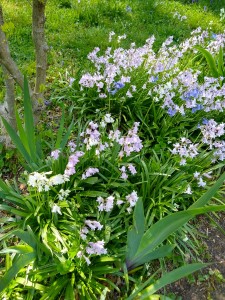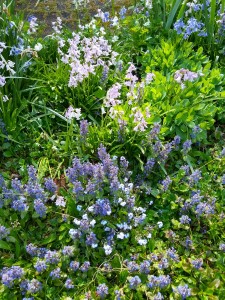 Back in the fifteenth and sixteenth centuries, European weavers created large tapestries that depicted tales from history or mythology. They adorned the backgrounds of those tapestries with hundreds of small, irregularly-spaced flowers, often against a green or dark background. This style, called “millefleur”, meaning “thousand flowers” was meant to suggest a flower-filled field. The best known example is the famous “The Lady and the Unicorn” tapestry series created by Flemish weavers around 1500 and now housed in New York’s Metropolitan Museum of Art.
Back in the fifteenth and sixteenth centuries, European weavers created large tapestries that depicted tales from history or mythology. They adorned the backgrounds of those tapestries with hundreds of small, irregularly-spaced flowers, often against a green or dark background. This style, called “millefleur”, meaning “thousand flowers” was meant to suggest a flower-filled field. The best known example is the famous “The Lady and the Unicorn” tapestry series created by Flemish weavers around 1500 and now housed in New York’s Metropolitan Museum of Art.
When I look at my backyard in spring, I think that all I need is a unicorn. The grassy area—which is not large enough to be called a field, or even a proper lawn—is dotted with hundreds of common violets—Viola soraria– in white, purple and bi-colored varieties. The violets are augmented by an abundant number of ajugas or Ajuga reptans, with dark purple basal leaves and plump blue flower spikes rising six inches above the floral fray. Elbowing the ajugas are a host of Spanish bluebells or Hyacinthoides hispanica. “Bluebells” is a misnomer, because the majority of them are pink with blue overtones. Some are true blue and a very few are white. Crowds of forget-me-nots or Myosotis surge around the edges of this flowery mead. Every once in awhile, a few pink forget-me-nots manage to prevail over their blue-flowered relatives. They are just numerous enough to draw the eye for a moment.
People who like putting green-style lawns would be appalled at this array of perennial weeds and weedy perennials. I love them and even if I didn’t, I would have to acknowledge that they are the colorful lemonade that Nature and I have made out of the lemons of thin soil.
Grass is hard to grow in my lower backyard. Roots from the neighbors’ large trees have spread through the area, guzzling nutrients that would help nourish conventional lawn grass. I have enriched the surrounding garden beds with organic material to encourage mixed plantings of shrubs, perennials and annuals, but have not invested that kind of effort in the lawn. To be perfectly honest, lawn grass is one of the few plants for which I feel almost no affinity. I can’t imagine communing with it in the way that I commune with my ornamental plants. I am not particularly interested in its history. Lawn grass, in short, does not sing to me, though it often produces curses when it strays into the garden beds.
So, I let the spring flowers rampage over the lawn area in the backyard. The purple violets appear first, followed by their white and bi-colored relatives, which are then joined by the forget-me-nots. The ajugas and Spanish bluebells, being larger and showier, arrive last in a wave of color. In a cool spring like this one, all the flowers hang around for a lengthy period, producing a tapestry-like effect. I wait to mow what little grass exists in between all those volunteer plants until the flowers have faded. This means that parts of the lawn/tapestry look a little untidy from time to time as grass tries to grow up in its midst. I put up with that, or rather, I choose not to see that, because I am so enamored of the flowers.
Where did all these plants come from? I would like to take credit for them, but I am responsible for little other than encouraging them. The white and purple violets were here when I arrived. They multiply faster than rabbits and I have let them have their way with the property. The bi-colored violets, which are white with blue/purple freckles, are descendents of a blue-centered white violet given to me by a friend years ago. I installed it in my garden and it returned the following year with freckles instead of a central blue patch. Go figure.
The ajuga were also on site when we bought the house. Ajuga spreads via runners and the runners run wild at my place. The Spanish bluebells were also here. They grow from small bulbs, with the bulbs producing offsets that expand the clumps. I think the squirrels, virtually brainless, but ever ready to transplant anything, have helped the spread of the bluebells.
The forget-me-nots are descended from a single clump donated by a friend shortly after we moved in. They have self seeded and jumped around like fleas on a dog’s back. If I pull some out accidentally, they come back twice as vigorously the following year.
The best part of all this verdure is that four-legged plant predators do not eat any of it. The resident groundhog, which has already taken on the dimensions of the mature Orson Welles, ignores them as it waddles rapidly through the flowers. The deer may walk on the ajuga, but the flower spikes generally spring back up and the basal leaves are unaffected. It would take a nuclear attack to deter the bluebells.
I call my flowery mead a success. Since it is in the back, most people don’t see it. Slaves to garden tidiness would probably turn up their noses, but since their noses are rarely on the premises, I am free to enjoy both the flowers and the absence of guilt that comes with them.
